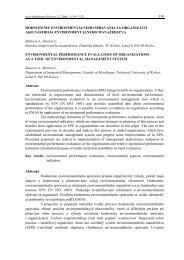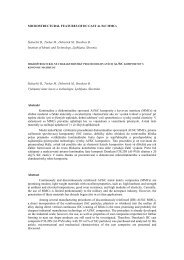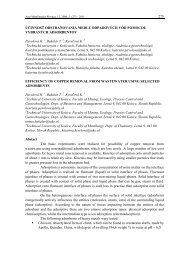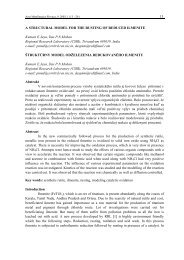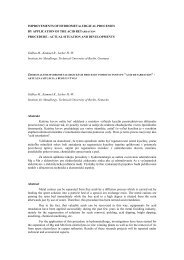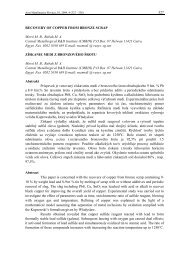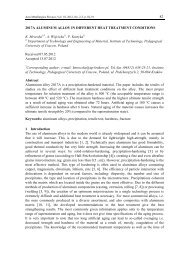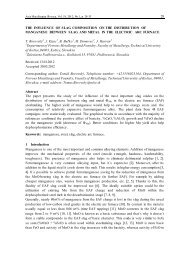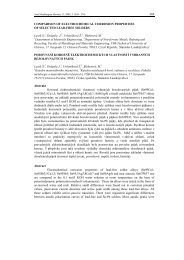199 mathematical modeling of mold-filling and solidification - Acta ...
199 mathematical modeling of mold-filling and solidification - Acta ...
199 mathematical modeling of mold-filling and solidification - Acta ...
You also want an ePaper? Increase the reach of your titles
YUMPU automatically turns print PDFs into web optimized ePapers that Google loves.
<strong>Acta</strong> Metallurgica Slovaca, 15, 2009, 3 (<strong>199</strong> - 207) 203<br />
obtained from Eq. (6) gives the information for the free surface. The cells with F(r,t) values<br />
between 0 <strong>and</strong> 1 are the free surface cells. The VOF method has been applied successfully to<br />
many engineering problems involving free surfaces including the <strong>mold</strong> <strong>filling</strong> problem.<br />
However, since the original VOF method uses an explicit differencing method in time, large<br />
computational time is required to analyze a typical <strong>filling</strong> problem.<br />
Im et al. [13] state that the use a time-implicit VOF method to alleviate the severe<br />
time step restriction is more efficient than the time-explicit VOF method. The time implicit VOF<br />
method is based on the assumption that a cell being filled cannot transmit fluid to its neighboring<br />
cells until it is completely filled. Once the cell is filled, it can transmit fluid to neighboring cells.<br />
However, According to McBride et al. [14] almost all viable simulation tools for the simulation<br />
<strong>of</strong> free-surface flow in shaped castings use a fixed grid approach as defined by the <strong>mold</strong><br />
geometry, <strong>and</strong> they typically employ the concept <strong>of</strong> volume <strong>of</strong> fluid (VOF) to track the interface,<br />
as originally proposed by Hirt <strong>and</strong> Nichols [15].<br />
The numerical method used to analyze fluid flow <strong>and</strong> thermal behavior during <strong>and</strong><br />
after <strong>filling</strong> in the <strong>mold</strong> is described as follows [13]. Continuity, momentum, energy <strong>and</strong> F(r,t)-<br />
transport equations are discretized using the fully implicit method in time. Firstly, the velocity<br />
<strong>and</strong> pressure fields are obtained from the momentum <strong>and</strong> continuity equations. Then the new<br />
fluid configuration is computed from Eq. (6). The energy equation is solved for the fluidoccupied<br />
region to determine the temperature <strong>and</strong> the liquid fraction. The updated values <strong>of</strong><br />
F(r,t) are utilized to modify the velocity <strong>and</strong> pressure, <strong>and</strong> then the temperatures <strong>and</strong> liquid<br />
fractions are updated based on the modified velocity <strong>and</strong> pressure. This iteration procedure is<br />
repeated until the total fluid volume <strong>and</strong> temperature changes are small enough to satisfy the<br />
prescribed convergence criteria. If the convergence criteria are satisfied, the time is advanced.<br />
This time-implicit VOF method is adopted to reduce the tremendous computation time that is<br />
required when the original VOF method is used [13].<br />
According to Kermanpur et al. [16], <strong>mold</strong> <strong>filling</strong> problems involve tracking free<br />
surfaces that are the boundaries between liquid metal <strong>and</strong> the surrounding air. The most<br />
commonly used method to describe free surfaces is the VOF. It enables the tracking <strong>of</strong> transientfree<br />
surfaces with arbitrary topology <strong>and</strong> deformations (e.g., fluid surface break-up <strong>and</strong><br />
coalescence). The ‘true’ VOF method consists <strong>of</strong> three main components:<br />
1. A fluid fraction function F(r,t) which is equal to 1.0 in fluid regions, <strong>and</strong> equal to 0.0 in<br />
voids. Since the fluid configuration may change with time, F(r,t) is a function <strong>of</strong> time,<br />
t, as well as space, r. Averaged over a computational control volume, the fluid fraction<br />
function has a fractional value in cells containing a free surface.<br />
2. Zero shear stress <strong>and</strong> constant pressure boundary conditions are applied at free<br />
surfaces.<br />
3. A special advection algorithm is used for tracking sharp free surfaces.<br />
The boundary conditions at the free surface are; normal <strong>and</strong> tangential stresses equal<br />
to zero.<br />
A free surface advection method must preserve the sharpness <strong>of</strong> the interface having<br />
minimal free surface distortion. Generally, such advection algorithms are based on geometric<br />
reconstruction <strong>of</strong> the free surface using the values <strong>of</strong> F(r,t) at the grid nodes [16]. Sometimes, a<br />
free surface is approximated by a density discontinuity between metal <strong>and</strong> air <strong>and</strong> flow equations<br />
are solved for both fluids. In that case it is difficult to enforce correct boundary conditions at the<br />
surface. This is because free surface pressure <strong>and</strong> velocities in the two-fluid approach are not set



